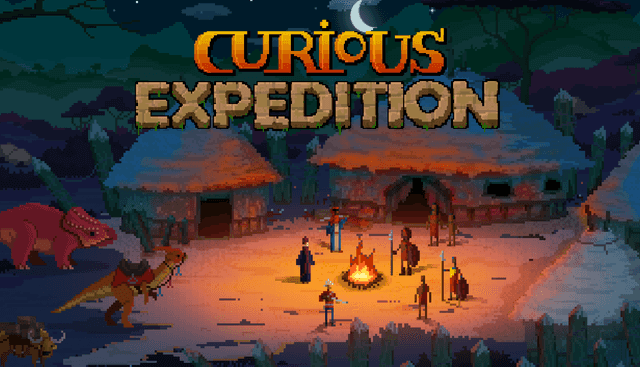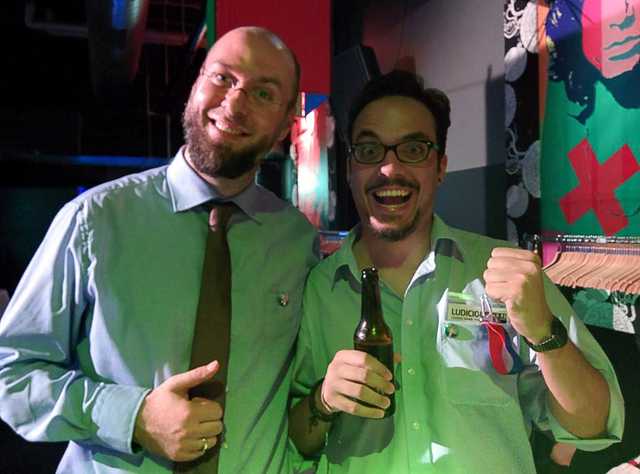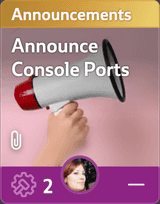
Riad is the product manager of Codecks. He is also the co-founder of indie games company Maschinen-Mensch and still believes that Street Fighter 2 is the most beautiful video game ever created. Coincidentally he also believes that Codecks is the best project management tool for game developers. Apparently he has been creating video games for over 14 years now and considers himself a productivity nerd: scrum, kanban, extreme programming, waterfall, seinfeld. He has tried it all.
Codecks is a project management tool inspired by collectible card games. Sounds interesting? Check out our homepage for more information.
The complete sales history of modest indie hit game Curious Expedition (2021 Update)
This post has been updated in 2021 with an additional paragraph about 2020 and all its sales data.
The first commercial version of Curious Expedition was released at the end of 2014. In this blog post I will give you the complete overview of all the sales numbers of these first seven years. This is our complete indie game case study: How many units we sold, when we sold them, in which territories, on which platforms. I will also tell how it felt to tank with our game and how we were able to eventually turn it into a bigger success than we ever imagined.
In case you never heard about it: Curious Expedition is a roguelike expedition game in which you explore uncharted lands, fight dangerous beasts and encounter unknown tribes, all while trying to not go insane or getting forsaken by your own trek members. It’s the first game by our Berlin game studio Maschinen-Mensch.

Over time, it was released on all major store fronts: Steam, GOG, HumbleStore and itch.io. We recently released console versions for Xbox, PS and Nintendo Switch, but that happened after the initial five years and will not be covered here.
The big picture
I’ll give you the grand yearly numbers right away. For NDA reasons I can’t go into specific details about how much we sold on each distribution platform, but will instead lump all our digital sales together. All of this units are gross value, that means before tax, distribution rev share and charge backs (usually around 5-15%).
Units sold (2014-2020)
Revenue (2014-2020)
As you can see Curious Expedition had its most successful years two full years after releasing the first version. If you’re interested in how we managed to do that just keep reading the detailed history below:
Year 1 (2014) - Alpha
Beginnings
Johannes and I met at Berlin game developer Yager where we both worked on the war/anti-war AAA game Spec Ops: The Line. We decided to start working on a hobby project around 2012, with the grand dream of potentially going indie with it. Curious Expedition (or Terra Incognita as it was called back then) was the first game that we both agreed on. The idea came to me when I browsed a National Geographic magazine in the waiting room of my dentist.
During this hobbyist phase we struggled quite a bit with the game. Our interest in the premise never waned, but we went through dozens of game mechanics without really being able to nail down the core loop concept. During that time we met multiple times with the intention of quitting the game, only to give it two more months over and over again. We made a leap of faith when we decided to quit our AAA jobs in the beginning of 2014.
The birth of our company Maschinen-Mensch (at some point we had called ourselves Hic Sunt Leones) was eased by a €50,000 grant from Medienboard Berlin-Brandenburg. Thankfully we also had a bit of personal savings that helped us survive the initial months since the grant is only allowed to cover 50% of the project costs.
The first thing we did when finally started working full-time on the game, was completely ripping it apart and disabling all features until nothing but a simplistic movement prototype remained. From here we rebuilt all the aspects of the game. Our hope that we finally were onto something was kindled by the positive feedback from our small game designer meetup that we started around the same time.
At the end of 2014 we pushed ourselves to finally release the painfully barebone initial alpha of the game. Complete sections of the game were still missing: when you ran into combat a text message would tell you that we basically didn’t get to that part yet. But we had no choice: our money was running out at this point.
Alpha Editions
We released the first buyable version of Curious Expedition on our own homepage where we sold it via the Humble Widget. We took some inspiration from all the new Kickstarter projects that were created in 2014 and showed that players appreciated different pricing and feature options for purchasing games.
Here’s an overview of all editions we started with:
Day 1 sales
Our first release date was November 18th 2014 and we sold in total drum rolls.. 61 copies for a total revenue of $1,203. Not exactly dream numbers when you just quit your high profile AAA job and spent all your savings on creating this indie game, which has to work out for you to be able to remain an indie game dev.
Here’s a break-down of the unit types sold on that first day:
Launch Day (November 18th 2014)
Back to work
After pushing the big frightening release button, I remember that we went to a coincidental drink out with some friends from the game dev scene. I still remember how they asked curiously how much we had already sold. I felt bad about telling them that this great indie game experiment we had launched had pretty much tanked at this point. But there was no point in giving up now, so on Monday we got back into the office (which was my living room) and just started working on our next big alpha update.
I turned my old iPad into a live sales metrics board showing the current sales in the style of an airport destinations board and we hooked up to a hefty cash register sound whenever somebody bought a copy of our game. I remember with joy the small moments of celebration when during work the sound would come up and how we high-fived. I also remember those stretches of hours when there was no single sound being played though and we were checking if our metrics were broken, before realizing once again that this was just the state of affairs.
In 2014 we sold in total 793 units for a revenue of $10,965 with an average price point of $13.83.

Year 2 (2015) - Early Access
In 2015 we pushed hard on extending Curious Expedition 1. Despite the slow start we were nowhere done and set our hopes into appearing in digital storefronts. So far we had tried to bring people to our small website, but since the players didn’t come to the game, it was time to bring the game to the players.
Alpha Videos
Up to this point we had mostly relied on twitter to attract players to our homepage. Today we’re close to 6,000 followers on twitter, but back then we were struggling for a long time to even get to 500 followers.
To build up visibility and hopefully share our excitement about our game, we started recording videos for the numerous alpha updates that we did. Looking at them now, they are a crazy trip down the memory lane to our past selves. Here’s the one for Alpha 4, which is special since it is the alpha in which we added combat for the first time.
For each alpha update we announced the release day weeks in advance and approached it like a mini-release with marketing material and a strong theme for each of these updates. We made sure to have at least one highly visible “hero feature” per alpha release.
For this update our main focus were our dice challenges. We had been working on combat prototypes for over a year at this point, but as we added more and more combat features, we realized that it became a big centerpiece and we were over-scoping heavily, so we made the hard decision to completely remove combat and make a game that would work solely based on the merits of its unique travel gameplay first.
We did this even though we felt that we had stumbled into an interesting spin on combat: a 1-dimensional dungeon crawler, where instead of on a grid your character and the enemies would be laid out on a line.
Free weekend!
Before going to stores, we decided to try our luck on drawing more people to our website one last time and did a free weekend! Players could play the game right from their web browser without having to download anything. This was not only nice for lowering entry barriers but also made it very easy for us to revoke access to the game after the weekend was done.
We expected to have fewer sales during the free weekend with an uptick in sales afterwards from players who wanted to play more. To our surprise we had the highest sales during the time when the game was free. Afterwards the sales normalized pretty quickly again.
Sales before and after the free weekend (Feb 2015)
Storefront!
On May 19th we finally entered Early Access on Steam as our first store front and this is when Curious Expedition finally changed trajectory to become a success. We still sold the extra editions through our own homepage but the vast majority of sales now happened on the digital storefronts.
Pricing Strategy
We increased our price from $12 to $15 as we released the Early Access version. We felt it was fair enough since we had spent many months adding additional content to the game. The following chart shows the average price point per year.
Average Price per Year (2015-2020)
We also decided to be as timid as possible regarding sales. Until we reached the 1.0 phase we decided to not do any sales that went beyond 20%. You can see a timeline of our general sale price reductions here.
On-Sale Reduction (2015-2020)
In 2015 we sold in total 21,266 units for a revenue of $302,534 with an average price point of $14.23.
Year 3 (2016) - Gold Release
Going Gold
This is the year that we released the 1.0 version of Curious Expedition after over a year of Early Access. We also landed in more online stores: getting a presence in the HumbleStore and being lucky enough to be chosen by GOG as one of the very few games that they chose for their Games in Production program.
We read that you only get one big push in your game’s lifetime: either your Kickstarter campaign or your early access release or your full release. Luckily for us this turned out to not be the case. Not only did the game keep selling well in 2016, the release of the 1.0 version even surpassed our sales records until that point and pushed the game to sell more units than it had in 2015. After the gold release we started applying more sales and going beyond 20%. We were still extremely conservative for a game that had been released for two years now.
Art Games
This year we also started working with the Goethe Institute, a non-profit German cultural association operational worldwide, promoting the study of the German language abroad and encouraging international cultural exchange and relations. We acted as consultants and hosts for art games - a series of eight game jams on the topic of art and politics and got to travel around the world and meet amazing game developers and artists around the world. That is a story for another post though.
In 2016 we sold in total 25,055 units for a revenue of $324,242 with an average price point of $12.94.
Year 4 (2017) - The Chinese Year
Arctic Expanse
After our success so far, we felt a bit more at ease in terms of company stability and started working on a big free Arctic Expanse DLC as a thank you to our players. Here’s our Alpha update video for that release. You can see that we stepped up our alpha videos quite a bit since that first video with pure voice over.
Chinese localization
In 2017 we received an email from a Chinese translation community called Project Gutenberg (not related to the other famous Project Gutenberg creating free ebooks). They offered to translate our game for free into Traditional and Simplified Chinese, which was a massive undertaking, considering that our game featured over 80,000 words. It sounded too good to be true and to be honest we didn’t expect that this would ever lead to something. Little did we know that Craft and his team would knock it out of the park.
While they were busy translating the game, I added Chinese language support to our custom engine, which turned out tricky in some areas as I had no prior experience about the intricacies of their character system. Not only did Gutenberg translate the game as they had promised, but I was shocked when they even sent me full code snippets fixing particularly bugs in my code without having access to our code base. They had reverse compiled my game engine and sent me around 50 lines of updated code in the localization part. And it didn’t stop there: they even reworked our pixel art with Chinese characters in exactly the same art style as the rest of the game.

Little did we know how much of an impact the Chinese sales would have on our game. It has become our top market at this point. Here’s a chart showing the distribution between our two biggest sales regions over time:
Comparison of North American Sales vs Asian Sales (2015-2020)
Here’s an overview of the territories we sold Curious Expedition in over the years in total.
Sales by Territories (2014-2020)
Units by Territories (2014-2020)
Steam allows for custom pricing per currency and region. By default this pricing is not done by converting the lead currency just one-to-one to other currencies, but also takes into account regional customs regarding game pricing. That means that the Chinese edition actually sells for ¥48, which corresponds to around $6,90 (instead of the regular $15). The same logic also applies to a lot of other currencies and markets.
As you can see below this drives down the average price point quite a bit, but is easily made up for by the big amount of new players.
Curious vs Renowned
The first time we visited Gamescom in 2014 we stumbled on a game that looked eerily similar to our game in terms of fantasy and setting. That game was Renowned Explorers. To be honest we didn’t exactly know what to think of it. We had worked so hard on our unusual game setting and all of the sudden these successful indies that had created REUS before had made a similar game as ours. Of course we didn’t invent the fantasy of going on adventurous expeditions but yet we felt a bit worried, especially considering we were struggling with surviving 2014.
Over the years we made it a ritual to meet up again for Gamescom and it turned out that the folks of Abbey Games were actually really nice people who were just working as hard as we did. So instead of getting annoyed by the constant game confusion as we could tell from various forum threads in our and their community we decided to turn the potential animosity into something playful and positive and invited them to create a bundle with us. They actually had joked about doing this in 2014 already, now it was time to take them up for their word.
We created a weird video promo where we bashed each other’s game and even sent out competing press releases downtalking the other respective game. Those press releases went exactly nowhere, but the resulting store promos that we got out of our unusual approach resulted in a huge sales spike which has been the strongest to this date.
Humble Very Positive Bundle
In 2017 we also participated in a Humble Bundle based around games having a very positive rating on Steam (8.0 or more). The bundle sold 91,604 units and made $570,359 in revenue.
The other games in the bundle were:
- Super Mega Baseball: Extra Innings
- The Deadly Tower of Monsters SE
- They Bleed Pixels
- Crashlands
- UnderRail
- Stephen’s Sausage Roll
Curious Expedition and Stephen’s Sausage Roll were on the higher tier, only unlocking if players spent more than $10 on the bundle. I can’t go into further details about the exact numbers, but we’re happy to have participated and didn’t notice this having any negative effect on our other sales channels.
Since the Humble Bundle is such an outlier in regards of unit count and average price point I’m not including its effect in any of the other sales statistics in this blog post. All revenue and unit counts are calculated ignoring the Humble Bundle.
In 2017 we sold in total 49,409 units for $416,865 with an average price point of $8.44.
Year 5 (2018) - Modding
In this year we spent a lot of time prototyping on the procedural murder mystery game Curious Case and also explored some areas which we didn’t get to before. One of them was building a nice demo version of the game which again could be played easily from the browser.
Modding
Right at the end of 2017 we added modding support for our game. There were several things which made that particuralary interesting for our game:
- The game was programmed in a custom engine (see this blog post about all the tools that we used for creating the game), so almost all our tools were also custom and in full control of us, making it easy to open them up for the community
- All our game content was contained in text files, which were easy to edit. To make it even more straight-forward, I created a plugin for visual studio code
- The low resolution of the pixel art of the game was beginner friendly so we had a lot of people that were able to add basic content.
- The procedural roguelike nature of the game made it easy to add content which would be seen by other players as they played through the game. We allowed enabling multiple mods at once.
The detailed analysis of this is probably worth a separate blog article but at first glance was that for us the modding did not yield a huge return. Maybe because we added it so late in the game’s lifetime?
One cool aspect of it was that it allowed for some weird content and just this French youtube series alone with their weird mods probably made the feature at least break even financially. Here’s one of our biggest Let’s Plays featuring duck characters:
This was also the time when the core team of Johannes and me was finally extended with our first programmer employee. It was the first step towards slowly growing our team.
CuriousExpedition.io
At some point in 2018 I played a massive multiplayer io version of Minesweeper and found it surprisingly addictive. That game is not online anymore, but I spent several hours mindlessly extending the shared world and zooming in and out of the massive world game map. I thought if this simple narrative-free game would already be this interesting, how would a massive online version of Curious Expedition look like?
Towards the second half of 2018 we decided to find out and implemented a huge async multiplayer version of Curious Expedition using the web technology which we already had. The small prototype idea grew into a big internal project which consumed us for several months until it was finally ready for launch.
Unfortunately CE.io didn’t really take off as a standalone version. We had no experience with live service games at all and soon realized that betting more on the game would require considerably more resources, something we didn’t have as we were also working on our prototype for Curious Case and working towards Curious Expedition 2.
Eventually we decided to merge this huge new game mode back into the base version of the game and release it as a huge free multiplayer mode of the existing Curious Expedition 1. This way it acted as a final big farewell gift to our Curious Expedition 1 players and for everybody that wanted to continue following our Curious Expedition journey we even added a way for unlocking the closed Curious Expedition 2 alpha directly by finding the golden pyramid in this new RIVALS mode.
Platforms
We were lucky to find Thunderful and at the end of 2018 as we spent a lot of time filling up the new team and getting everything ready to start the production on Curious Expedition 2 in the next year. Starting with porting the whole game to Unity at the end of 2018 so that our partners could focus on porting the Unity version to individual consoles, while we used it as foundation for our work on Curious Expedition 2.
Here’s an overview of the amount of CE1 units sold by platform before coming to consoles:
Total Units per Platform (2014-2020)
In 2018 we sold 37,395 units in total for $271,858 with an average price point of $7.27.
Year 6 (2019) - Sequel Development
Curious Expedition 2
Besides working on the big free multiplayer update, we didn’t work much on Curious Expedition 1 this year. Most of the team worked on Curious Expedition 2, which we recently released on Early Access. You can find more info about it on the Steam page.
Codecks
We started using Codecks as our internal production tool in 2015. We were initially introduced to it by co-founder Emmanuel - our fellow coworker from Yager. We started to share an office with parts of the Codecks team and over the years and product iterations we fell in love with it more and more. In 2019 we made it official: we started a joined Codecks company and are co-developing the next generation of project management for game developers together now.
Our goal is to make a production tool that is pragmatic, powerful and yet easy to learn with playfulness and visual appeal at its core. A tool that shows actual game developer experience guiding every design and feature choice for the tool.
In 2019 we sold 39,189 units of Curious Expedition in total for a revenue of $263,270 with an average price point of $6.72.
Year 7 (2020) - Console Ports and Sequel Release
Console Ports
While the studio was busy polishing the sequel, our publisher Thunderful oversaw the porting of Curious Expedition to consoles (Nintendo Switch, PlayStation 4 & XBox One). The console versions are obviously very late in the life cycle of the game, which is not ideal but we felt it was worthwhile introducing our IP to the console community so that there would be some familiarity once we also launch the sequel on consoles.
Declining shelf life
Even though Curious Expedition still sold over 30,000 copies in 2020, the end of the shelf life can be felt - the only real impact on sales comes from big discounts, preferably in combination with features (e.g. Midweek Madness) on Steam, which in turn lets the average price point drop significantly.
In 2020 we sold 34,966 units on PC in total for a revenue of $188,479 with an average price point of $5.39.
Sequel: Early Access & Release
In 2020 we continued to put the finishing touches on Curious Expedition 2, which was released on June 17th in Early Access on Steam. Through-out the release of the sequel the sales for CE1 were not impacted negatively.
Early Access brought a lot of old and new fans and testers to the table. While we originally planned the full release for the sequel at the end of the year, all the stress and complications of the year 2020 caused us to delay our full release ever so slightly: The final release date was 28th January 2021. We are extremely proud and happy with the result and the efforts of our team on the sequel - and we’re looking forward to the development of several DLCs to be released this year!
You can buy it on Steam right now!
Conclusion
From 2014 to 2020 we sold 217,816 units in total for a gross revenue of $1,827,930 with an average price point of $8,39. These numbers do not include the units we sold via the Humble Bundle. Including those the game has been purchased by over 250,000 players in total until the end of 2019.
That concludes this overview of the financial and personal history of Curious Expedition. Is indie game development profitable? As you have seen by now, it was for us and for this game. Did we get rich by creating a game? Not at all, if you add up all the store rev shares, tax and production costs and the fact that we’re putting in all of the profit to allow us to build a company that we love working at and that is able to hopefully do much more cool stuff in the future. That is more than we can ask for and all thanks to all the players that supported us throughout the years.
I hope to have also shared a glimpse into life as an indie game developer. There are of course a lot of stories that I left out for the sake of attempted briefness. For example how we co-founded Saftladen, the biggest indie games coworking space in Berlin with 50 indie devs at this point. Or how two fans started working on a board game adaption of Curious Expedition and how that ended up inspiring the look of Curious Expedition 2 in a surprising way.
Whether you’re an indie dev yourself, contemplating entering the market or an interested player, I hope you found this video game case study useful. I remember how I searched for any concrete financial numbers while getting started. This article is our way of adding back to that pool of knowledge and thanking all the devs who were willing to share their data. I hope you find this information as interesting or even inspiring as I did when starting out.


